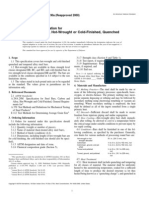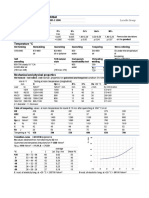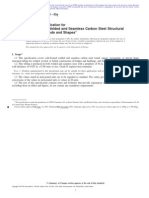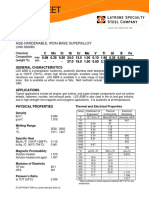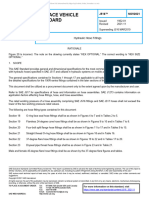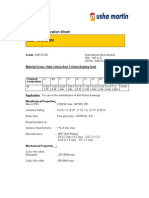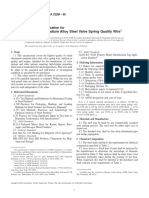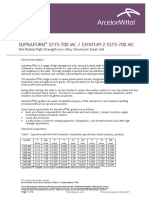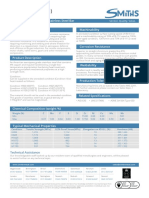Steel 4340
Steel 4340
Uploaded by
skyheighst1594184Copyright:
Available Formats
Steel 4340
Steel 4340
Uploaded by
skyheighst1594184Copyright
Available Formats
Share this document
Did you find this document useful?
Is this content inappropriate?
Copyright:
Available Formats
Steel 4340
Steel 4340
Uploaded by
skyheighst1594184Copyright:
Available Formats
Steel 4340 Property Results Chemistry Data : [top] Carbon Chromium Iron Manganese Molybdenum Nickel Phosphorus Silicon
Sulphur Principal Design Features 0.38 - 0.43 0.7 - 0.9 Balance 0.6 - 0.8 0.2 - 0.3 1.65 - 2 0.035 max 0.15 - 0.3 0.04 max AISI 4340 is a heat treatable, low alloy steel containing nickel,chromium and molybdenum. It is known for its toughness and capability of developing high strength in the heat treated condition while retaining good fatigue strength. Typical applications are for structural use, such as aircraft landing gear, power transmission gears and shafts and other structural parts.
Applications
Machinability
Forming
Welding
Heat Treatment
Forging Hot Working
Cold Working
Annealing
Aging Tempering
Machining is best done with this alloy in the annealed or normalized and tempered condition. It can be machined by all conventional methods. However in the high strength conditions of 200 ksi or greater the machinability is only from 25% to 10% that of the alloy in the annealed condition. 4340 has good ductility in the annealed condition and most forming operations are carried out in that condition. It can be bent or formed by spinning or pressing in the annealed state. Bend radii should be 3t or greater. The alloy can be fusion or resistance welded. Preheat and post heat weld procedures should be followed when welding this alloy by established methods. Heat treatment for strengthening is done at 1525 F followed by an oil quench. For high strength (over 200 ksi) the alloy should first be normalized at 1650 F prior to heat treatment. See "Tempering" for strength levels. Forging may be done in the range of 2250 F max. down to 1800 F. 4340 has very good cold forming capability so that hot working should not be needed. Hot working in any but the annealed condition can affect the strength level. Consult the alloy supplier in regard to hot working. The 4340 alloy may be cold worked, in the annealed condition, by conventional methods and tooling. It has good ductility. A full anneal may be done at 1550 F followed by controlled (furnace) cooling at a rate not faster than 50 F per hour down to 600 F. From 600 F it may be air cooled. Not applicable to this alloy. The temperature for tempering depends upon the strength level desired. Before tempering the alloy should be in the heat treated or normalized & heat treated condition - see
Hardening Other Comments
"Heat Treatment". For strength levels in the 260 - 280 ksi range temper at 450 F. For strength in the 125 - 200 ksi range temper at 950 F. Do NOT temper the alloy if it is in the 220 260 ksi strength range as tempering can result in degradation of impact resistance for this level of strength. The alloy will harden by cold working or by heat treatment -see "Heat Treatment" and "Tempering". AISI 4340 is considered to be a "through hardening" steel such that large section sizes can still be heat treated to high strength.
Physical Data : [top] Density (lb / cu. in.) Specific Gravity Specific Heat (Btu/lb/Deg F - [32-212 Deg F]) Melting Point (Deg F) Thermal Conductivity Mean Coeff Thermal Expansion Modulus of Elasticity Tension Forum Result: What happens to the physical size of 4340 during heat treating? I have some shafts to machine from 4340 51/2" dia stock, to an average size of 5.000" dia x 18" long. Will the material grow or shrink and by how much? It will be quenched and tempered to 40-44 RC. I can tell you from first hand experience the material is going to go crazy on you. I have always heat treat to full hard then draw three times to desired RC. If you can watch the three draws you'll notice the first draw will take it to the desired RC, The second draw at same temp it will go up in RC. The third draw will make it go back down and really really stabilize it for you. leave your self some machine stock. If you have any dowel holes be prepared to chase the holes with a carbide reamer. Be careful if you have to chase a taped thread. Preface... I'm not a heat treater but deal with our heat treater often so can probably head you in the right direction. First off... simple enough to ask your heat treater. They won't mind flexing their know-how for you. I have had lengthy conversations with one particular heat treater we use and he's a wealth of information and just an all around good guy. We're buds and more than once he's extended our tooling life by better understanding what we were doing with a tool. Maybe varying our hardness or suggesting a different grade of material etc... That said... They'll shrink some. They'll also be prone to bending if not positioned correct or supported by something flat during heat treat. You need to ask your heat treater if he can stand them up on end without having them fall etc. Longer shafts it's nice if you can drill & tap shaft end and supply hooks in each shaft on one end so they can be lifted for quench. These are short enough they shouldn't be a problem. They'll fit in a basket but they'll stay straighter if they can stay standing up on end. Far as how much they're going to shrink? Ask your heat treater. It won't be much. Maybe .002-.004 if I had to guess. The bending potential CAN be more of the issue. But... if I were making these things... and spoke with the heat treater about keeping them upright I'd still allow for approx. .03-.04 total (.015-.02 per side) to be machined after heat treat for clean-up. That cut might drop your hardness by a point... if that. If your heat treater whines about giving them special care... find another heat treater. When you say average size of 5.000 I expect there are steps in this part. Best to keep generous radii at all transitions prior to heat treat also. This is to reduce likelihood of cracking during quench. External corners need to at least be broken before heat treat, as they too are a stress concentration area. 0.28 7.8 0.116 2600 21 6.6 33
You can look up... Jominy test 4340... on the www or ask your heat treater what the depth of hardness might end up at. A part that thick will still be soft in the center. I'd expect that the heat affected zone will only be about 1/2" deep with hardness tapering off closer to center you get. That's usually not a bad thing in the applications I've seen this material used. Tough center with wear resistant surface. Keep this in mind when rough machining. If steps on these shafts are deep you will lose hardness at the smaller diameters. Also always a good practice to call out a double temper on things like this. This will help ensure a complete transition of the grain. This is more critical in different grades and depends some on the application, but just a good habit to get into. Costs you an extra 50 bucks or whatever but can make or break a tool. Especially in more critical tooling applications. Tooling built for any sort of shock loads... like Hot work tool steels or S grades etc. are much tougher or less susceptible to cracking if a double or triple temper is performed. Need that smooth transition of grain and nice even equally sized grain. Another tid bit. We've used vacuum heat treat on 4140-4340 in the past and although we had a little less distortion... the gas quench couldn't strip the heat out of the material quickly enough to get the hardness up at the initial quench like good old oil can. Meaning I doubt you'll achieve 44 RC surface on 5 inch diameter in a vacuum furnace. Might be wrong though? Could look into that if these aren't critical and you don't want to do a finish cut. Thanks for the info. Yes there are steps in the shafts but not much difference in diameter. The diameters are critical so finishing after heat treating will be necessary, I was going to leave .06 to make sure straightness wont be a problem. They do have the means (high tonage press) to straighten them if necessary. There are 3/4-10 holes in each end so lifting by hooks will be provided. Thanks again for the info so I feel I would be safe with my original plan. 40 RC wont be that hard to cut for some finishing and to correct the length. Quenching and tempering steel will actually grow the part. After heat treating, the part is hardest just under the surface. Plus, the very surface can have decarb and grain boundary oxide, both of which are undesireable. Since you'll be grinding the shaft to finish dimensions, material growth and undesireable surface effects will be removed and you'll be left with hard and healthy material at the susrface (assuming the part doesn't suffer grinding burn during final machining).
STEEL 1. Processes (Heat treatment): a. Quenching b. Annealing, Cryogenic Treatment, Thermomechanical processing Focus on heat treat procedure for: Ultrahigh strength materials, maraging steels, powder metallurgy ferrous alloys 2. Hardening of steel: a. Flame hardening b. Conventional treatment like Carburizing, nitriding and carbonitriding c. High energy processes using laser beams/ electron beams. Surface modification Techniques a. Ion implantation b. PVD/CVD coatings c. Surface melting/ surface alloying processes Linear changes are approximately one-third the volume changes. During the formation of austenite from an original microstructure of ferrite and pearlite or tempered martensite, the volume (and hence the length) decreases with the formation of the dense austenite
3.
1. 2.
phase (see Fig. 3). From the elongation curves, the start and finish times for austenite formation, usually defined as 1% and 99% transformation, respectively, can be derived. These times are then conveniently plotted on a temperature-log time diagram (Fig. 4). Also plotted in this diagram are the Ac1 and Ac3 temperatures. Below Ac1 no austenite can form, and between Ac1 and Ac3 the end product is a mixture of ferrite and austenite. Notice that a considerable overheating is required to complete the transformation in a short time. The original microstructure also plays a great role. A finely distributed structure like tempered martensite is more rapidly transformed to austenite than, for instance, a ferriticpearlitic structure. This is particularly true for alloyed steels with carbideforming alloying elements such as chromium and molybdenum. It is important that the heating rate to the hold temperature be very high if a true isothermal diagram is to be obtained. The transformation start curve shows as an upper-limiting estimate of the time (in seconds) for nucleation, . The isovolume fraction curves x can semiempirically be described by a relation of the type (Ref 12): /8 exp( / ) . ( ) x 2N . Q RT f I X T t= D (Eq 1) where x is the volume fraction of the transformed phase, Q is an activation energy related to the boundary diffusion activation energies for the alloying elements, N is the ASTM grain size number for austenite, T is the temperature (in degrees Kelvin), T is the undercooling (A3 - T) for ferrite, (A1 - T) for pearlite and an empirical value for bainite, f is a linear function of the volume fractions of carbon and alloying elements and I is the volume fraction integral giving the dependence of the transformed phase on the volume fraction. The combined effect of the I/T3 factor, which increases with decreasing undercooling (that is, increasing temperature) and the exp (Q/RT) factor, which increases with decreasing temperature, results in long nucleation times, x, for high and low temperatures and short nucleation times for intermediate temperatures. The C-shape can thus be obtained and understood. The factor 2N/8 is included to take into consideration the fact that the transformation rate is larger for smaller austenite grain sizes.
You might also like
- Lotrène Q 50100: High Density Polyethylene ResinDocument1 pageLotrène Q 50100: High Density Polyethylene Resinyang chinaNo ratings yet
- Reprocessed Plastic GranulesDocument6 pagesReprocessed Plastic Granulesnitin pandeyNo ratings yet
- A434Document3 pagesA434alirioNo ratings yet
- A A 59588BDocument9 pagesA A 59588BHayleyNo ratings yet
- Aisi 4340 Alloy Steel (Uns g43400)Document4 pagesAisi 4340 Alloy Steel (Uns g43400)LamhotFernandoSihombingNo ratings yet
- Astm E527-83Document7 pagesAstm E527-83Ar AjaNo ratings yet
- Norma ASTM A380.27738-1Document12 pagesNorma ASTM A380.27738-1windeletaNo ratings yet
- B689 - 97 R08 Standard Specification For Electroplated Engineering Nickel CoatingsDocument7 pagesB689 - 97 R08 Standard Specification For Electroplated Engineering Nickel CoatingsRodolfo100% (1)
- Animal Feed MillingDocument17 pagesAnimal Feed MillingsibungNo ratings yet
- Correlation of Hardness Values To Tensile Strength: Semih Genculu, P.EDocument9 pagesCorrelation of Hardness Values To Tensile Strength: Semih Genculu, P.ERakesh DasNo ratings yet
- 30 CR Ni Mo 8Document2 pages30 CR Ni Mo 8Amy GriffinNo ratings yet
- A 500 - 03 Qtuwmc1sruqDocument7 pagesA 500 - 03 Qtuwmc1sruqtran_lamNo ratings yet
- Astm A488 A488m 01Document6 pagesAstm A488 A488m 01joanadarcrosa856No ratings yet
- PRC-2003G Heat Treating Nickel AlloysDocument9 pagesPRC-2003G Heat Treating Nickel AlloysHenryNo ratings yet
- Sa 106 PDFDocument16 pagesSa 106 PDFRaju SkNo ratings yet
- Brazing Allloy Cusil ABADocument12 pagesBrazing Allloy Cusil ABADheeraj SharmaNo ratings yet
- Lss-A286 Astm A453 PDFDocument2 pagesLss-A286 Astm A453 PDFmazolasboNo ratings yet
- QP STD R 008 NDT Standard Part 3 UtDocument13 pagesQP STD R 008 NDT Standard Part 3 UtthmaraishriNo ratings yet
- Welded UNS N08120, UNS N08800, UNS N08810, and UNS N08811 Alloy TubesDocument3 pagesWelded UNS N08120, UNS N08800, UNS N08810, and UNS N08811 Alloy TubesRed RedNo ratings yet
- Astm B 367 - 09Document6 pagesAstm B 367 - 09taker6No ratings yet
- Alloy286 - ASTM A453 660 DatasheetDocument2 pagesAlloy286 - ASTM A453 660 Datasheetn1ghtfallNo ratings yet
- ASTM A480-A480M-04aDocument24 pagesASTM A480-A480M-04aNadhiraNo ratings yet
- Failure of A Nickel Aluminium Bronze (NAB)Document16 pagesFailure of A Nickel Aluminium Bronze (NAB)EduardoNo ratings yet
- Tensile ASTM C749Document13 pagesTensile ASTM C749hamidrezaghezelNo ratings yet
- Asme Section II A Sa-376 Sa-376mDocument10 pagesAsme Section II A Sa-376 Sa-376mAnonymous GhPzn1xNo ratings yet
- A 29 - A 29M - 16Document17 pagesA 29 - A 29M - 16Isabel Christina Gonzalez MoralesNo ratings yet
- B16 - B16M 10 (Reapproved 2015)Document5 pagesB16 - B16M 10 (Reapproved 2015)orlando acevedoNo ratings yet
- 13-8 MoDocument2 pages13-8 MofedaquiNo ratings yet
- Sa 276Document12 pagesSa 276edisson_barreraNo ratings yet
- Astm b85 1984Document7 pagesAstm b85 1984Siddhi Sharma100% (1)
- Surface Vehicle Standard: Hydraulic Hose FittingsDocument33 pagesSurface Vehicle Standard: Hydraulic Hose FittingsEdgar GarciaNo ratings yet
- Astm A285 1978Document5 pagesAstm A285 1978Juan Manuel Cruz MárquezNo ratings yet
- Mil STD 1312BDocument44 pagesMil STD 1312BgreatsteelNo ratings yet
- Astm F38Document8 pagesAstm F38duvan castellanosNo ratings yet
- Astm A449 1978Document7 pagesAstm A449 1978rensieoviNo ratings yet
- Astm A420 A420m 22Document4 pagesAstm A420 A420m 22nghuuthang72No ratings yet
- Excel SC 1018-1020Document5 pagesExcel SC 1018-1020Nabil MaksudNo ratings yet
- Is 277-2018Document10 pagesIs 277-2018Kundan SinghNo ratings yet
- NS-1-20. TraceabilityDocument5 pagesNS-1-20. TraceabilityWHWENNo ratings yet
- Bearing Steel Material Specification Sheet SAE52100Document1 pageBearing Steel Material Specification Sheet SAE52100Christy Vijay Roy HenryNo ratings yet
- A 1008 - A 1008M - 02 Qtewmdgtmdjfmq - PDFDocument7 pagesA 1008 - A 1008M - 02 Qtewmdgtmdjfmq - PDFTiến Lượng NguyễnNo ratings yet
- Ansi b17 2 Woodruff Keys Flat Bottom Type 1Document3 pagesAnsi b17 2 Woodruff Keys Flat Bottom Type 1rbagriNo ratings yet
- Babbitt Casting and Babbitt Spraying Processes Case Study PDFDocument3 pagesBabbitt Casting and Babbitt Spraying Processes Case Study PDFsaurabhjerps231221No ratings yet
- Astm A1014Document3 pagesAstm A1014Shunmugavel KarpagamNo ratings yet
- Astm A537-A537m-95-2000Document4 pagesAstm A537-A537m-95-2000NadhiraNo ratings yet
- AMS5772Document7 pagesAMS5772Adrian FinichiuNo ratings yet
- A 232 - A 232m - 99 Qtizmi9bmjmytqDocument4 pagesA 232 - A 232m - 99 Qtizmi9bmjmytqRafael GarciaNo ratings yet
- Astm B 824Document6 pagesAstm B 824houk sukNo ratings yet
- Appendix 28 Alternative Corner Weld Joint Detail For Box Headers For Air-Cooled Heat ExchangersDocument3 pagesAppendix 28 Alternative Corner Weld Joint Detail For Box Headers For Air-Cooled Heat ExchangersBinay K SrivastawaNo ratings yet
- Inconel 718Document34 pagesInconel 718TUNISH KUMAR MBA-2017No ratings yet
- MS 264Document15 pagesMS 264Felipe De la cruzNo ratings yet
- Astm A494-A494m-17Document7 pagesAstm A494-A494m-17Gabriel Perez CruzNo ratings yet
- Din 1.2714Document3 pagesDin 1.2714harieduidNo ratings yet
- Nitriding 4340 ADocument8 pagesNitriding 4340 AyanuarNo ratings yet
- Supraform S315-700 MC / EN10149-2 S315-700 MC: Hot Rolled High Strength Low Alloy Structural Steel CoilDocument2 pagesSupraform S315-700 MC / EN10149-2 S315-700 MC: Hot Rolled High Strength Low Alloy Structural Steel CoilHugo RodriguezNo ratings yet
- Asme B18.2.6 2003Document11 pagesAsme B18.2.6 2003Jesse ChenNo ratings yet
- ASME SA213 T9 Seamless Alloy Steel TubesDocument7 pagesASME SA213 T9 Seamless Alloy Steel TubesJayminNo ratings yet
- Sp-Eng-004 Rev. 19Document16 pagesSp-Eng-004 Rev. 19fael_fvNo ratings yet
- 17 4ph PDFDocument1 page17 4ph PDFMalavikaVarmaNo ratings yet
- Material GradesDocument32 pagesMaterial GradesMarius PopaNo ratings yet
- Drdiecast 2012marDocument1 pageDrdiecast 2012marsobheysaidNo ratings yet
- 431 Martensitic Stainless Steel BarDocument4 pages431 Martensitic Stainless Steel Barzulu80No ratings yet
- Metallurgy of KnivesDocument4 pagesMetallurgy of KnivesOliver Alfaro100% (1)
- Boiler Making for Boiler Makers - A Practical Treatise on Work in the ShopFrom EverandBoiler Making for Boiler Makers - A Practical Treatise on Work in the ShopRating: 4.5 out of 5 stars4.5/5 (2)
- Soldering Electronic Components 2nd EditionFrom EverandSoldering Electronic Components 2nd EditionRating: 3 out of 5 stars3/5 (2)
- Drawn by Mass Date Rev Sheet ScaleDocument1 pageDrawn by Mass Date Rev Sheet ScaleElectrical InstrumentsNo ratings yet
- Dies Inserts Catalog Low ResolutionDocument48 pagesDies Inserts Catalog Low Resolutiongustavo rivasNo ratings yet
- GTAW and Power SourcesDocument18 pagesGTAW and Power SourcesRavi Kumar SinghNo ratings yet
- SGV ValveDocument2 pagesSGV Valvekhaled greenNo ratings yet
- Fundamentals of Packaging-Ovop MalawiDocument38 pagesFundamentals of Packaging-Ovop MalawiXerxa LinganNo ratings yet
- Imachining Technology DisadvantagesDocument2 pagesImachining Technology DisadvantagesNew ConceptsNo ratings yet
- American Society of Mechanical Engineers (ASME) CodesDocument11 pagesAmerican Society of Mechanical Engineers (ASME) CodesfrdnNo ratings yet
- Seminar Report HydroformingDocument11 pagesSeminar Report HydroformingAnuj Mandloi100% (2)
- Pyrolysis of Polypropylene PDFDocument164 pagesPyrolysis of Polypropylene PDFJaviera Aburto Ulloa50% (2)
- PDS Hempel's Speed-Dry Primer 13770 en-GBDocument2 pagesPDS Hempel's Speed-Dry Primer 13770 en-GBSaul Antayhua0% (1)
- Crude DistillationDocument32 pagesCrude DistillationIzziyyahNo ratings yet
- Socket Weld & Screwed FittingsDocument31 pagesSocket Weld & Screwed FittingsJavier GarcíaNo ratings yet
- Pidilite Industries Limited: Technical Data Sheet Fevicol HeatxDocument2 pagesPidilite Industries Limited: Technical Data Sheet Fevicol HeatxParas Agrawal50% (2)
- IS 817 - Part1 - Training of Welders PDFDocument26 pagesIS 817 - Part1 - Training of Welders PDFDeepak RajanNo ratings yet
- Detent PinsDocument1 pageDetent PinstopendwarriorNo ratings yet
- Arasan Polymers Hosur 23Document13 pagesArasan Polymers Hosur 23Saravanan KNo ratings yet
- Manufacturing Procedure Specification. SD2. (Subsea) .: Industrial ServicesDocument42 pagesManufacturing Procedure Specification. SD2. (Subsea) .: Industrial ServicescarydacNo ratings yet
- Traditional Katana Forging Techniques_Makhniuk AntonDocument5 pagesTraditional Katana Forging Techniques_Makhniuk Anton9-1-1No ratings yet
- AwsDocument14 pagesAwssarkararup75% (4)
- Antifoaming Agents For Submerged Microbial Fermentation: BITS Pilani, Hyderabad CampusDocument6 pagesAntifoaming Agents For Submerged Microbial Fermentation: BITS Pilani, Hyderabad CampusShreyanshJain100% (1)
- Pengolahan Limbah Cair Industri TahuDocument6 pagesPengolahan Limbah Cair Industri TahuDenni RachmawanNo ratings yet
- William Winterburn: CNC Machinist, Machinist/ToolmakerDocument2 pagesWilliam Winterburn: CNC Machinist, Machinist/ToolmakerLucky PradhanNo ratings yet
- Riview HVOFDocument4 pagesRiview HVOFscribd_anjirNo ratings yet
- Drying EquipmentsDocument18 pagesDrying EquipmentsCeazar Justine FuluganNo ratings yet
- DNV CG 0044Document16 pagesDNV CG 0044Cheok CH100% (1)


